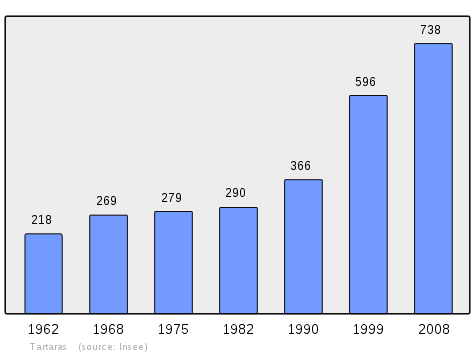Tartaras
| Tartaras | ||
|---|---|---|
|
Double lock and rock tunnel | ||
| ||
 Tartaras | ||
|
Location within Auvergne-Rhône-Alpes region  Tartaras | ||
| Coordinates: 45°33′17″N 4°40′09″E / 45.5547°N 4.6692°ECoordinates: 45°33′17″N 4°40′09″E / 45.5547°N 4.6692°E | ||
| Country | France | |
| Region | Auvergne-Rhône-Alpes | |
| Department | Loire | |
| Arrondissement | Saint-Étienne | |
| Canton | Rive-de-Gier | |
| Government | ||
| • Mayor | Gérard Manet | |
| Area1 | 3.91 km2 (1.51 sq mi) | |
| Population (2006)2 | 720 | |
| • Density | 180/km2 (480/sq mi) | |
| Time zone | CET (UTC+1) | |
| • Summer (DST) | CEST (UTC+2) | |
| INSEE/Postal code | 42307 / 42800 | |
| Elevation |
190–348 m (623–1,142 ft) (avg. 320 m or 1,050 ft) | |
|
1 French Land Register data, which excludes lakes, ponds, glaciers > 1 km² (0.386 sq mi or 247 acres) and river estuaries. 2 Population without double counting: residents of multiple communes (e.g., students and military personnel) only counted once. | ||
Tartaras is a commune in the Loire department in central France. It is in the Gier valley just north of the river, between Rive-de-Gier to the west and Saint-Romain-en-Gier to the east.
History
The village dates back to the Roman era. Gallo-Roman sarcophagi are still visible in the town. During the 19th century Tartarus was in the heart of a coal basin.
Population

Sites
The maison familiale rurale de Tartaras (Tartarus rural family home) is an institution recognized by the Ministry of Agriculture that offers training schemes in the 4th of the professional baccalaureate: horticulture and landscape works.[1]
The Givors canal, built in 1761-81, passed by the village. At coordinates 45°33′00″N 4°40′25″E / 45.550114°N 4.673738°E in Tartaras a tunnel 100 metres (330 ft) long and 5 metres (16 ft) wide was broken through solid rock.[2] The tunnel and double lock at its entrance have been preserved as a monument, although the canal has mostly been filled in.[3]
Notable people
Charles Bossut (1730-1814) was born in Tartarus. He was a geometer, mathematician, member of the French Academy of Sciences (elected in 1768), corresponding member of the Academy of Berlin and Adademy of Bologna, honorary member of the Academy of St. Petersburg (1778), a collaborator with Denis Diderot for the mathematical part of the Encyclopedia, the father of the experimental hydrodynamics. Member, with Condorcet and the Abbé Rochon, of the commission of feasibility of canal.[4]
References
Citations
Sources
- "Canal de Givors". ProjetBabel (in French). Retrieved 2013-08-25.
- "Maison Familiale Rurale de Tartaras". Maison Familiale Rurale de Tartaras. Retrieved 2013-08-26.
- O'Connor, J J; Robertson, E F (August 2006). "Charles Bossut". Retrieved 2013-08-26.
- Rochet, Marc (2013). "Les gens de Tartaras et leurs métiers à travers les actes" (in French). Retrieved 2013-08-25.
| Wikimedia Commons has media related to Tartaras. |

.svg.png)